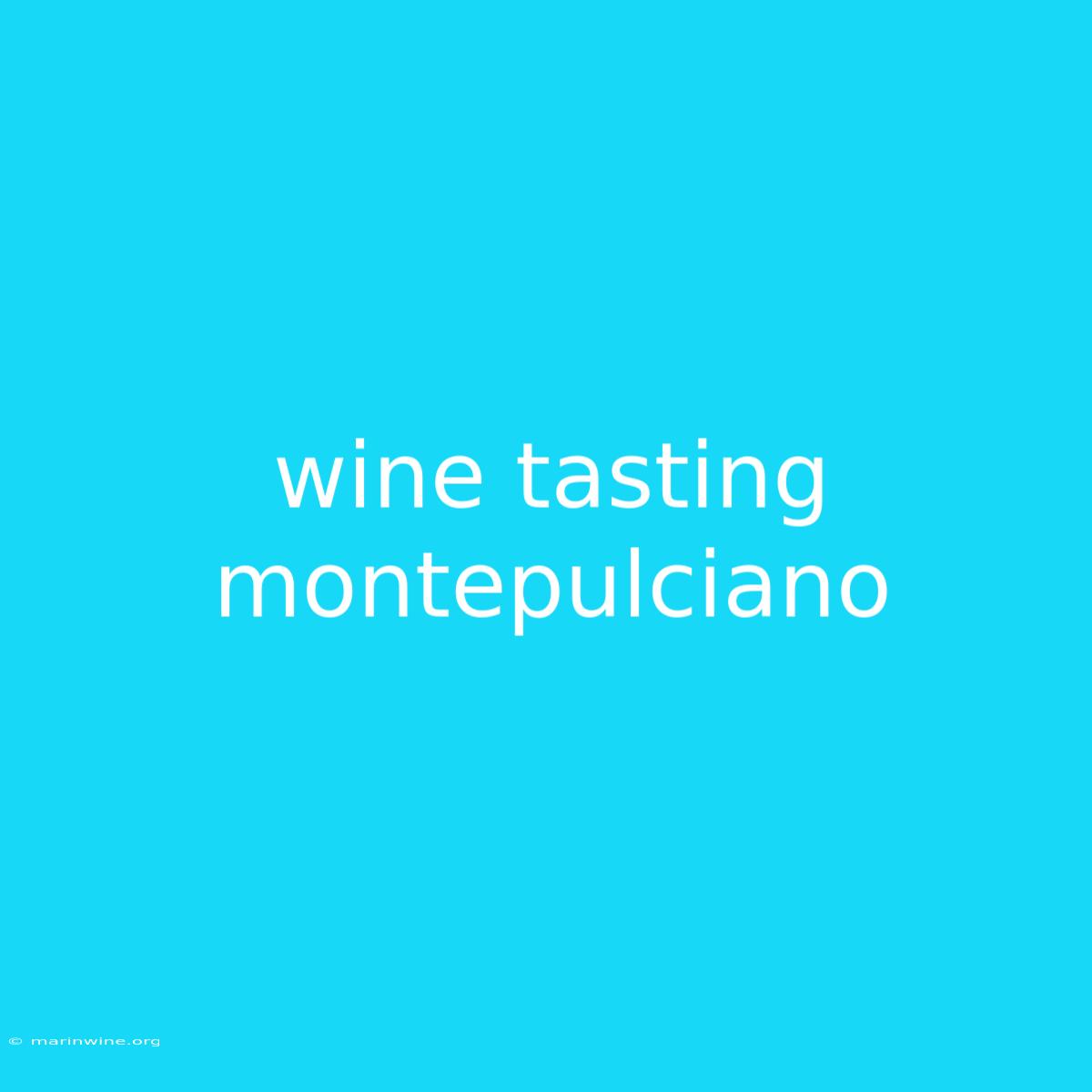Unveiling the Secrets of Montepulciano Wine: A Journey Through Flavor and History
Have you ever wondered what makes Montepulciano wine so special? This bold Italian red is renowned for its rich flavors and captivating history. Let's embark on a journey to explore the essence of Montepulciano, uncovering its unique characteristics and why it's a must-try for any wine enthusiast.
Why Montepulciano Wine Matters
Montepulciano is more than just a grape varietal; it's a symbol of Italian winemaking tradition. This article delves into the fascinating world of Montepulciano, exploring its origins, production methods, key characteristics, and its place within the broader landscape of Italian wines.
Key Takeaways of Montepulciano Wine
| Key Aspect | Description |
|---|---|
| Grape Variety | Predominantly Montepulciano, with occasional blending |
| Region of Origin | Primarily Abruzzo and central Italy |
| Flavor Profile | Full-bodied, with notes of black fruit, cherry, plum, spice, and earthy undertones |
| Style | Dry, red wine |
| Food Pairing | Ideal with pasta dishes, red meat, grilled vegetables, and aged cheeses |
Montepulciano Wine
Understanding the Grape
Montepulciano, the grape that gives this wine its name, is one of Italy's most widely planted varieties. It thrives in the sunny hills of central and southern Italy, particularly in the region of Abruzzo.
Key Aspects of the Montepulciano Grape:
- Adaptability: Montepulciano is highly adaptable to various soil types and climates, contributing to its popularity among Italian winemakers.
- Fruit Forward: The grape is known for producing wines with intense fruit flavors, primarily black fruit and berry notes.
- Tannin Structure: Montepulciano wines typically possess a robust tannin structure, adding complexity and age-worthiness.
Winemaking Traditions
Montepulciano wines are produced using traditional methods, with a focus on preserving the grape's unique character. The winemaking process involves:
- Harvest: Grapes are hand-harvested at optimal ripeness to ensure maximum flavor and aroma.
- Fermentation: Fermentation takes place in stainless steel tanks or oak barrels, allowing for the extraction of color, tannins, and flavor.
- Aging: Montepulciano wines often undergo aging in oak barrels, which adds complexity and smoothness.
The Distinctive Flavor Profile
Montepulciano wine is characterized by a vibrant and bold flavor profile. The primary notes include:
- Black Fruit: Ripe black cherries, plums, and blackberries dominate the flavor spectrum.
- Spicy Elements: Subtle hints of pepper, cinnamon, and clove add complexity to the palate.
- Earthy Undertones: Mineral notes and earthy hints contribute to the wine's overall richness.
Pairing Montepulciano with Food
The robust nature of Montepulciano makes it a versatile wine for pairing with various foods. Some ideal pairings include:
- Pasta Dishes: Rich pasta sauces, such as Bolognese and Amatriciana, complement the wine's bold flavors.
- Red Meat: Grilled steaks, lamb chops, and hearty roasts pair beautifully with the wine's tannins.
- Grilled Vegetables: The wine's fruity notes enhance the flavors of grilled vegetables like eggplant, peppers, and zucchini.
- Aged Cheeses: The robust flavors of aged cheeses, such as Parmesan and Pecorino Romano, stand up well to the wine's complexity.
Exploring the World of Montepulciano Wines
Montepulciano wines are available in various styles, each offering a unique experience.
Key Classifications:
- Cerasuolo d'Abruzzo: A lighter-bodied, rosé-style wine produced from Montepulciano grapes.
- Montepulciano d'Abruzzo: The classic expression of the grape, known for its full-bodied character and fruit-forward profile.
- Montepulciano d'Abruzzo Riserva: A higher-quality version of Montepulciano d'Abruzzo, aged for a minimum of two years.
FAQ about Montepulciano Wine
Q: How long does Montepulciano wine age? A: Montepulciano wines can age gracefully for 5-10 years, with some high-quality examples capable of aging for even longer.
Q: Is Montepulciano wine sweet? A: Montepulciano is a dry red wine, meaning it has little to no residual sugar.
Q: Where can I find Montepulciano wine? A: Look for Montepulciano wine at your local wine shop or online retailers specializing in Italian wines.
Q: What other Italian wines are similar to Montepulciano? A: Other Italian red wines with similar characteristics include Sangiovese, Nero d'Avola, and Aglianico.
Tips for Enjoying Montepulciano Wine
- Serve chilled: For optimal enjoyment, serve Montepulciano wine slightly chilled, around 60-65°F.
- Decant: If you're enjoying a mature Montepulciano, decanting it for 30-60 minutes will allow the wine to breathe and release its aromas.
- Pair with the right food: Experiment with various food pairings to discover your favorite combinations.
- Explore different producers: Try wines from different regions and producers to experience the full spectrum of Montepulciano styles.
Summary of Montepulciano Wine
Montepulciano wine stands as a testament to the rich heritage of Italian winemaking. Its full-bodied flavors, complex aromas, and ability to age gracefully make it a truly unique and rewarding experience. Whether you're a seasoned wine connoisseur or a curious newcomer, exploring the world of Montepulciano wine is an adventure worth taking.
Closing Message: Next time you're searching for a captivating Italian red, reach for a bottle of Montepulciano. You'll be rewarded with an unforgettable journey through flavors and history.

